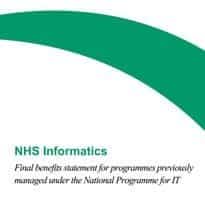The Department of Health released its final report on the benefits of NPfIT in June, six days before it told the Public Accounts Committee that it would not be available until September.
EHI has discovered that the DH website says the ‘Final Benefits Statement for Programmes Previously Managed Under the National Programme for IT’, was published on 6 June.
The statement is the DH’s response to a request by the committee in August 2011.
At a meeting on 12 June, PAC chair Margaret Hodge asked Tim Donohoe, the senior responsible owner for the local service provider programmes at the DH, when the benefits statement would be made public.
“We are working through to validate because we do not want to put in the public domain information that is incorrect. I think that we are probably three months away from being able to publish,” he answered.
Despite it being a final benefits statement on a government programme worth more than £12 billion, the report appears to have been published without a press release or media alert about its existence.
When Donohoe was asked at the meeting if he had a figure for the benefits of NPfIT to March 2012, he said: “I apologise to the committee that we do not yet have that figure. I will present it as soon as it is available.”
The final statement’s foreword by NHS England chief executive Sir David Nicholson says that an estimated £3.7 billion in benefits had been realised to March 2012, but the DH predicted that a total of £10.7 billion could be realised by the end of life of the systems.
This is against an expected cost of £9.8 billion over the same period.
The report acknowledges that benefits reported to date have been, in many cases, disappointing, but says the release of benefits should “increase significantly over time as the systems bed in and are able to be utilised to their full potential”.
It adds that in order to improve the potential for the forecast benefits to be realised, the government announced in September 2011 an “acceleration of the dismantling of the programme”.
It says there is now a greater emphasis on local ownership of benefits with local benefits realisation teams supported by a central team with expertise in benefits realisation established by the DH.
“This change of approach is reflected in the forecast benefits for local care record services. To date benefits reported are primarily due to more effective use of administrative staff and some costs avoided on system maintenance charges.
“Future benefits are expected to come from change in processes which will reduce cost through reductions in avoidable adverse incidents, reduction in medication budgets, and reductions in the length of time patients are expected to stay in hospital.
“The change in approach is also reflective of experience internationally, where benefits generally materialise sometime after systems have been successfully deployed.”
Murray Bywater, director of Silicon Bridge Research, said that measuring the actual financial benefits of deploying IT in the NHS is extremely difficult, due to long timescales and ongoing changes in the operational environment.
While the coalition government was not responsible for creating the national programme, they still want to “avoid the political embarrassment to the NHS of the whole thing costing masses and delivering little in return”.
He said the programme had provided benefits in terms of upgrading NHS hardware and IT infrastructure and establishing clearer recognition of the need to invest significant amounts of money in IT, “but it hasn’t really engaged effectively with clinicians on strategic change objectives”.
“NPfIT was a classic example of believing that if you spend enough money on IT, the savings will automatically flow. But that’s wrong thinking – IT expenditure has to be locked in to what is to be achieved in terms of clear strategic and operational objectives,” he said.
Bywater advocated a more locally owned approach.
“NHS organisations should be much more pragmatic and go for smaller more practical steps with specific responsibility at local level for achieving clearly defined strategic objectives,” he said.

